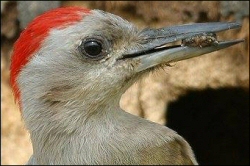Republic of Mali

Birding Mali
Mali, officially the Republic of Mali, is a landlocked nation in Western Africa. Mali is the seventh largest country in Africa, bordering Algeria on the north, Niger on the east, Burkina Faso and the Côte d’Ivoire on the south, Guinea on the south-west, and Senegal and Mauritania on the west. Its size is just over 1,240,000 km² with an estimated population of almost 12,000,000 so Mali is the world’s 24th-largest country and is comparable in size to South Africa or Peru. Most of the country lies in the southern Sahara, which produces a hot, dust-laden harmattan haze common during dry seasons. The country extends southwest through the subtropical Sahel to the Sudanian savanna zone.[8] Mali is mostly flat, rising to rolling northern plains covered by sand. The Adrar des Ifoghas lies in the northeast. Its capital is Bamako.Consisting of eight regions, Mali’s borders on the north reach deep into the middle of the Sahara, while the country’s southern region, where the majority of inhabitants live, features the Niger and Senegal rivers. The country’s economic structure centers around agriculture and fishing. Some of Mali’s natural resources include gold, uranium, and salt. Mali is considered to be one of the poorest nations in the world.Present-day Mali was once part of three West African empires that controlled trans-Saharan trade: the Ghana Empire, the Mali Empire (from which Mali is named), and the Songhai Empire. In the late 1800s, Mali fell under French control, becoming part of French Sudan. Mali gained independence in 1959 with Senegal, as the Mali Federation in 1959. A year later, the Mali Federation became the independent nation of Mali in 1960. After a long period of one-party rule, a 1991 coup led to the writing of a new constitution and the establishment of Mali as a democratic, multi-party state.
The country’s climate ranges from subtropical in the south to arid in the north. Most of the country receives negligible rainfall; droughts are frequent. Late June to early December is the rainy season. During this time, flooding of the Niger River is common. The nation has considerable natural resources, with gold, uranium, phosphates, kaolinite, salt and limestone being most widely exploited. Mali faces numerous environmental challenges, including desertification, deforestation, soil erosion, and inadequate supplies of potable water.
-
Wikipedia
GNU Free Documentation License
http://en.wikipedia.org/wiki/Mali
-
Number of bird species: 616
(As at September 2018)
Number of endemics: 1
Mali Firefinch Lagonosticta virata
-
iGoTerra Checklist
iGoTerra ChecklistFatbirder Associate iGoTerra offers the most comprehensive and up to date birds lists on the web
-
Birds of Western Africa
| By Nik Borrow & Ron Demey | Christopher Helm | 2014 | Edition 2 | Paperback | 592 pages, 266 plates with colour illustrations; colour distribution maps | ISBN: 9781472905680 Buy this book from NHBS.com -
Birds of Western and Central Africa
| By Ber van Perlo | Princeton University Press | 2003 | Paperback | 384 pages, 109 plates with colour illustrations; colour & b/w illustrations, 1500+ b/w distribution maps, colour maps | ISBN: 9780691007144 Buy this book from NHBS.com
-
African Bird Club
WebsiteMali contains within its borders huge extremes of habitats, vegetation and avifauna. Key wintering grounds for Palearctic waterbirds and breeding areas for African waterbirds are found where the Niger River forms a large interior delta between the historic cities of Djenne and Timbuktu. The Sahara desert occupies the entire northern half of Mali, and the Sahel zone runs through Mali from east to west, each with its own unique avifauna. -
West African Ornithological Society
WebsiteThe West African Ornithological Society grew out of the Nigerian Ornithologists
-
IBAs
WebsiteSatellite ViewThere are 17 Important Bird Areas (IBAs) and one secondary Endemic Bird Area (EBA) designated by BirdLife International in Mali -
NP Bafing
InformationSatellite ViewBafing National Park is the only protected area for chimpanzees within the Manding Plateau area. Woodlands dominate most of the landscape. -
NP Boucle du Baoulé
InformationSatellite ViewIt is part of a complex which also includes the Badinko Faunal Reserve, the Fina Faunal Reserve, the Kongossambougou Faunal Reserve and the Bossofola Forest Reserve. These preserved areas consist of desert and semi-desert areas, and include dry, lightly-wooded savannah, riverine forest and thorn scrub. Much of the large animal population in the country occurs in these types of habitat. -
NP Kouroufing
InformationSatellite View -
NP Wongo
InformationSatellite ViewThe Wongo National Park is found in Mali. It was established on the 16th of January 2002, and covers 534 km2 (206 sq mi).
-
Birding Africa
Tour OperatorMali offers an unusual combination of ancient history and productive birding in unique African landscapes. For those who like to regale their friends back home with stories of watching birds at the end of the earth, this is your chance.
-
2008 [03 March] - Mary Crickmore - Teriya Bugu
Report…Teriya Bugu, on the banks of the Bani river two hours drive north of Segou, is an affordable retreat and vacation center that was begun by a Catholic priest with a vision for environmentally responsible tourism that would produce economic benefit for local people. The center continues to operate after his death under the management of a Malian Non-Governmental Organization….

